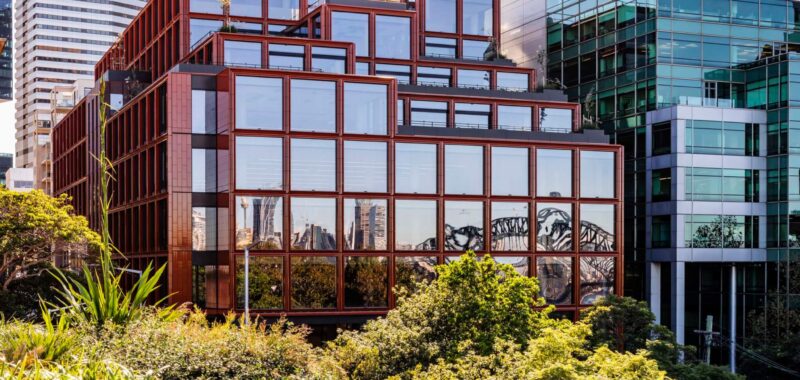- Architect:
- Woods Bagot
- Location:
- Sydney, Australia
- Completion Date:
- 2023
Australian architecture firm Woods Bagot has completed a new office building in North Sydney with spectacular views of the city’s harbor and downtown business district. Blue & William, named after its cross streets, is sited between a commercial area and a quiet suburb. To negotiate these disparate architectural languages, the architects framed the building’s large format windows with red-glazed terra-cotta baguettes, an addition that references the historic tile roofs of nearby residential structures.

Blue & William’s site was governed by local height and setback ordinances. Setbacks were required across the building’s southern facade in order to avoid overshadowing the grounds of an adjacent church. Conveniently, this created space for a series of outdoor terraces on the roof of the building, looking out over downtown Sydney.
The building also works with a sloped site—a common feature in Sydney, a city known for its rolling hills. A traditional masonry plinth was designed around the ground floor of the building as a nod to the materiality of surrounding brick structures.

Woods Bagot collaborated closely with Troy Donovan of Prism Facades on Blue & William’s envelope design. In addition to his work as a facade consultant, Donvan is also known for his popular Instagram page.
The pair tested a number of finishes and profile shapes before settling on the final design. As previously mentioned, terra-cotta was selected to meditate the transition from traditional brick homes to large glass office towers.
“The red [finish] is a very deliberate choice,” said Jason Fraser, principal at Woods Bagot. “Our design concept represented the rich terra-cotta color of the surrounding Marseille tile roofs that lead down to the harbor. These tiles are representative of many residential areas developed throughout Sydney and are an important part of our built heritage,” he added.

Created through an extrusion process, the individual terra-cotta pieces are fluted in profile—a nod to the art deco details on nearby structures. This feature, in combination with the application of a high-gloss finish, creates a reflective surface that mirrors the harbor and sunlight, taking full advantage of the building’s beautiful surroundings.
Fraser shared that one of the project’s main challenges was justifying the use of terra-cotta, an undeniably beautiful material that, unfortunately, comes at a high price tag.
“It is largely due to the high aspirations and trust of our client and the dedication of the selected contractor that we kept the terra-cotta facade,” he told AN. “And when we got that first facade prototype assembled for viewing, I think we all knew we had something special.”

In addition to its aesthetic beauty, terra-cotta is highly sustainable, possessing low amounts of embodied carbon. The facade materials are also designed to be disassembled and recycled. Overall, the building achieved a five-star green rating from the Green Building Council of Australia (GBCA).

